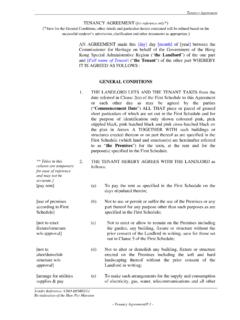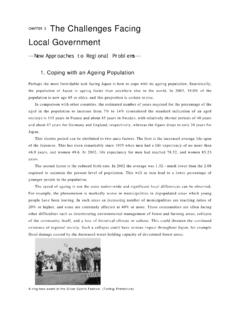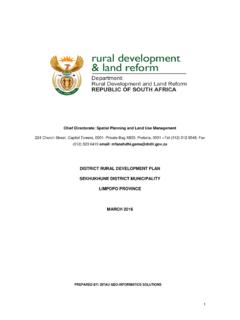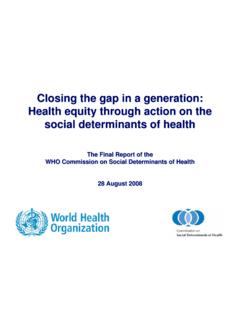Transcription of ISSUES IN AND FUTURE OF URBAN …
1 1 Sixth International Conference On Competition And Ownership In Land Passenger TransportISSUES IN AND FUTURE OF URBAN TRANSPORTATION AND TRAFFIC M ANAGEM ENT SYSTEM IN NIGERIABYDR. ONI DEPARTMENT OF GEOGRAPHY, UNIVERSITY OF LAGOS, AKOKA-LAGOS. CONTENTS1. Introduction 2. Contemporary ISSUES in Nigeria's URBAN Transportation. 3. The demand for and management of URBAN -transport 4. ISSUES and Problems 5. Problems of Nigeria's URBAN - Transport Development 6. Financing 7. Sustainable Transportation 8. FUTURE steps, Summary and conclusion 9. References Introduction In the next decade or so the population in the cities of Nigeria will double creating more than 11 cities with more than a million people.
2 This will increase demand for public transport not only in the provision of services but also in the provision of facilities. The increase in the population and economic development will place a services constraint on the local government enough to force them to look seriously into the issue of public transport. Three ISSUES at stake are financial resources and availability of appropriate manpower and maintenance. With economic recession in the country local government will face a serious problem in sourcing funds to provide transport services and facilities. Second, the quality of manpower at local level will pose a challenge to local governments to be able to plan, manage and coordinate public transport.
3 The third issue is maintenance; Nigeria depends entirely on importation of vehicle components and parts. The assembly plants are unable to meet the demand for buses even at this stage. The need to work inward is now more vital than ever before. To tackle these problems govt. may have to take a firm decision in the following ISSUES : 2 This paper tends to address contemporary ISSUES in Nigeria's URBAN Transportation; FUTURE of URBAN Transportation and traffic management system in Nigeria; Problems of Nigerian Transport development; Funding; Traffic restriction in Nigerian cities; Sustainable Transportation; and FUTURE steps geared towards adequacy, efficiency, safety, reliability and equity.
4 Contemporary ISSUES in Nigeria's URBAN transportationThe World Bank believes, that the following principles can be used to guide the development of URBAN transport policies in most cities, despite variations in socio-economic conditions. ECONOMIC VIABILITY Transport services and infrastructure should be provided if the benefits to society outweigh the additional costs to society. FINANCIAL VIABILITY Investment should be undertaken and services provided if the financing is self sustaining and enables replicability. EFFICIENCY By establishing suitable incentives for a given quantum of services, cost should be kept to a minimum; similarly, for a given cost, the quantity of services should be at a maximum.
5 The public sector has to return responsibility for many formidable tasks that cannot be assigned to private firms. Only the public sector can undertake, for example, traffic regulation, planning and management, the setting of safety standards, transport planning and the formulation of transport policy. Unfortunately, many of these exclusively governmental tasks have been neglected in Nigeria. The Growth in Demand for URBAN TransportFactors determining URBAN transport demand: 1. large increase in URBAN population, leading to a proportional increase in transport trips. 2. spread of URBAN areas - longer journeys and more fuel consumption 3.
6 Greater availability of motorised transport, regulating in more motorised trips and increases in fuel consumption; 4. increases in household incomes, creating a greater propensity for travel 5. increases in commercial and industrial activities; leading to increased volumes of service vehicles and freight traffic. Taken together, these factors result in a substantial increase in transport demand, which in turn has 3significant implications for city efficiency. The most notable effect is widespread traffic congestion, resulting in greatly increased costs - particularly in fuel consumption - and a serious loss of productivity, in commerce and industry.
7 The necessary basic expansion of road networks and transport systems to meet these demands, and the more complex and costly solutions that prevail, place a considerable burden on city budgets. Furthermore, household in URBAN communities are devoting increasingly large proportions of their incomes to transport, the budget implications being highest for low income groups in particular. The speed with which demand and costs have grown in Nigeria has often overwhelmed the institutions responsible for transport. But despite the serious implications, demand for road use has been allowed to grow virtually unrestrained.
8 Management of the Demand for Roads UseSeveral methods can be employed to reduce excessive demand. These include: road pricing schemes, in which motorists are charged for using congested roads area licensing schemes; in which low-occupancy vehicles pay charges for entering congested city centres during night hours physical restraints to discourage the movement of private cars across city centres parking controls designed to prevent long-term downtown parking by commuters while allowing normal business activities user taxes on fuel to restrain general use of vehicles financial restraints on vehicle ownership, such as high import duties, sales taxes, or annual licensing fees land use controls to influence the magnitude and type of transport demand.
9 If these measures are coupled with general improvements in traffic flows and public transport, thus benefiting the majority of road users, it should easier to win acceptance. FUTURE URBAN transport will witness improved URBAN land use revitalisation and the expansion of public transport under improved management and computer facilities. The ProblemThe challenges facing URBAN centres have continued to grow particularly within the past three decades. In fact, cities will increasingly face a seemingly paradoxical situation. The city serves as a magnet for employment opportunities, shops, services and leisure activities.
10 Over the years, it has become the epicentre of economic and social life and has been called upon to accommodate increasingly varied activities and house a growing proportion of the population. According to Bailly (1998), it is highly 4likely that, in the year 2010, around 50 cities worldwide will boast population of over 10 million. It is this success which may lead to the downfall of the city if its growth is not managed properly, particularly the aspect transport and traffic management. Today mobility has become a strong aspiration an expression of individual freedom. As the third millennium approaches, public transport has a tough time ahead.







